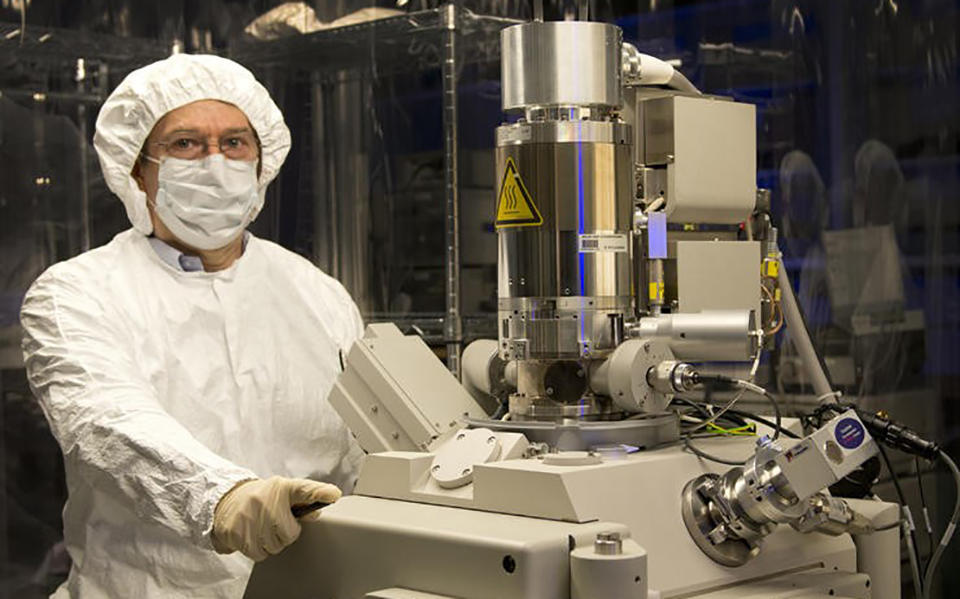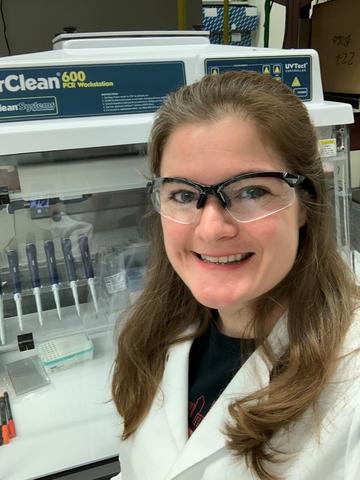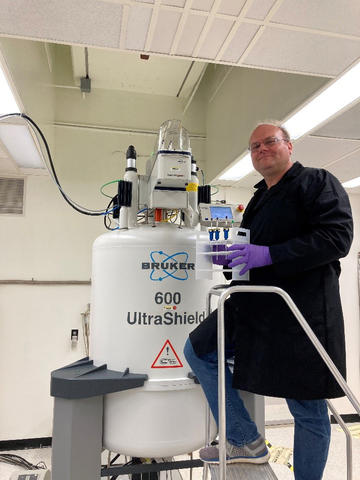Taking Measure
Just a Standard Blog

NIST engineer Andras Vladar in front of the scanning electron microscope he's using to image fabric samples from face coverings to assess their structural integrity after exposure to UV light.
I’ve been working from home since March 13. But even though I’ve been remote, I am still really connected to my colleagues — and have even created some new relationships. How’d that happen?
First off, my office — the Program Coordination Office at the National Institute of Standards and Technology (NIST) — is a great place to work. I interact with scientists and engineers from across our campus on a variety of important projects — from strategic planning to research partnerships — that help NIST. NIST has a variety of programs that cover literally the entire spectrum of science and technology, from cybersecurity and data analytics to fire research and advanced materials. This diversity is part of what makes my job so fun — and interesting.
In mid-March, some of NIST’s scientists were already working on important biological measurements to improve diagnostic testing for COVID-19. But NIST senior leadership suspected that our staff’s wide-ranging talents could be applied to address even more challenges during the pandemic.
We needed a way to reach all the staff quickly, to find out what possibilities they had in mind and help bring their ideas to fruition. Each of NIST’s six laboratory directors offered up a staff member to work with me on the collaboration team: Sarah Hughes from the Communications Technology Lab, Carmen Martinez from the Engineering Lab, Elham Tabassi from the Information Technology Lab, Nick Barbosa from the Material Measurement Lab, William Ratcliff from the NIST Center for Neutron Research, and Michelle Stephens from the Physical Measurement Lab.
This group had never worked together before. We were split with four of us based near NIST headquarters in Gaithersburg, Maryland, and three members based near NIST’s Boulder, Colorado, campus. But we were all committed to the effort of driving collaboration at a distance. We rolled up our sleeves, and within 24 hours we had a plan for what we named the “How Can NIST Help?” effort to generate ideas, share information, collaborate and inspire action to assist in the fight against COVID-19.
“How Can NIST Help?” included a call across NIST for ideas that showed promise of having a significant impact over the coming weeks or months. Of course, we also paid attention to safety, asking for ideas that could be accomplished by telework or limited on-site research. We flexed new muscles, using a variety of software and videoconferencing tools to encourage teamwork and information sharing while working from home.
In the past two months I have learned a lot about the NIST staff and their commitment to working on important problems. Our team solicited ideas for four weeks, starting in late March. Over that period, we received 75 unique entries from staff across the organization. The collaboration team reviewed ideas and worked with the laboratory leaders to identify projects to move forward.
Here are some of the cool projects that NIST staff are working on right now:

Biological Measurements — Some of our researchers have been in the laboratory working on measurements for detecting COVID-19, including developing a research-grade test material that manufacturers can use to calibrate their instruments. NIST is also co-organizing an international study to expand the measurement capabilities needed to standardize the performance of analytical methods used by diagnostic manufacturers, clinical laboratory-developed tests and international test standardization efforts.
Data and Analytics — Using their expertise in natural language processing and data curation, our staff have created tools to help researchers explore one of the richest datasets of articles about coronaviruses. NIST also launched a TREC-COVID effort to help search engine developers to evaluate and optimize their systems for searching through reams of COVID-related research.
Personal Protective Equipment (PPE) — A lot of the ideas submitted to “How Can NIST Help?” involved characterizing PPE (face shields, face coverings, gowns, etc.) performance and decontamination processes. It turned out that NIST has useful expertise that applies to these areas across our laboratories — including chemistry, additive manufacturing (3D printing), nanoscale imaging and more. NIST has expertise related to different decontamination methods from UV light to vapor treatments and, of course, deep knowledge of and professional connections to standards.
One project involves aerosol measurements to assess how cleaning procedures impact the performance of fabrics used in face coverings. Another project builds on lessons learned from a NIST-hosted workshop on ultraviolet disinfection to study the structural integrity of face coverings following irradiation, bringing together NIST experts in lighting, flow and imaging. There were so many submissions, in fact, that we had to call on NIST scientist David LaVan, a project leader, to help wrangle all the information. Why David? Well, turns out he’s a registered professional engineer and certified to repair scuba regulators!

Manufacturing and Industry — Several projects that directly support manufacturing and industry are in progress now, including funding opportunities announced by the NIST Manufacturing Extension Partnership and Manufacturing USA. NIST’s research chemists are consulting stakeholders, including manufacturers in the MEP network, to find ways they can apply their expertise to generate data and materials for accurate testing of hand sanitizer.
Volunteering — Some ideas showcased the ingenuity of our staff in their free time. We learned about their volunteer efforts to 3D-print face coverings and donate them to local organizations, and a grassroots group of our early-career staff is helping local students and teachers by holding virtual sessions where they talk about their careers in science, technology, engineering and math (STEM).
These projects and more are listed on the NIST website: www.nist.gov/coronavirus.
For me, launching the “How Can NIST Help?” effort was incredibly rewarding. Some of my colleagues have sent emails of appreciation for the collaboration team’s efforts, which means the world to me. I have made many new friends across NIST, and I look forward to seeing them soon.
Cover smart, do your part, slow the spread
Check out this post (and video) by Matt Staymates demonstrating the airflow when coughing with and without a face covering.
About the author
Related Posts
Comments
Fund undergraduate research programs where the best and brightest analytic students work on this challenge. They are living through the Coronavirus Pandemic and with their analytic minds possibly invent new approaches.
Execellent Article8
Thank you for this well-crafted, energy-filled article and the links to learn about the other How Can NIST Help projects. It's also great that a few college and high school interns are working on two projects - one in Wireless Innovations and one in Education. Thank you to the collaboration team for pulling this all together!
valuable information






This is a smart, succinct article that adds another level to NIST that was unknown to many of us at the local cybersecurity level. This is fascinating! Keep it up!